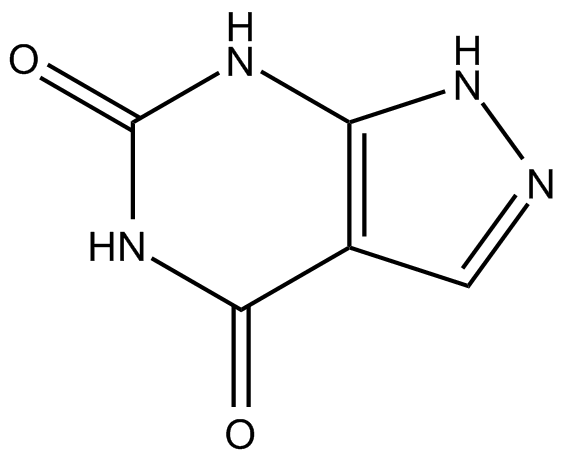Oxipurinol (Synonyms: Alloxanthine|NSC 76239) |
| Catalog No.GC10827 |
Oxipurinol (Oxipurinol), the major active metabolite of Allopurinol, is an inhibitor of xanthine oxidase.
Products are for research use only. Not for human use. We do not sell to patients.

Cas No.: 2465-59-0
Sample solution is provided at 25 µL, 10mM.
Oxipurinol is a xanthine oxidoreductase inhibitor.
Xanthine oxidoreductase (XO), a complex molybdoflavoenzyme present in milk and many other tissues, has been studied for many years. XO is generally recognized as a critical enzyme in purine catabolism.
In vitro: Allopurinol could be rapidly oxidized by XO to its active metabolite oxypurinol (both isosteres of hypoxanthine and xanthine, respectively), which also could inhibit XO. Oxypurinol was identified as a noncompetitive inhibitor of XO; the formation of this compound was reported to be responsible for much of the pharmacological activity of allopurinol. Moreover, both allopurinol and oxypurinol showed free radical scavenging effects in isolated hearts, and exerted cardioprotective effects despite no detectable XO activities [1].
In vivo: Animal study found that in the vasculature of hypercholesterolemic rabbits, oxypurinol treatment led to a decrease in vascular free radical production [1].
Clinical trial: The PK parameters of oxypurinol in subjects with normal renal function were found to be t((1/2)) of 23.3 +/- 6.0 hours, CL/F of 0.31 +/- 0.07 mL/min/kg, V(d)/F of 0.59 +/- 0.16 L/kg, and renal clearance relative to creatinine clearance. Oxypurinol has been found to be cleared almost entirely by urinary excretion and, thus the dosage of allopurinol should be reduced in renal impairment [2].
References:
[1] P. Pacher, A. Nivorozhkin and C. Szabó. Therapeutic effects of xanthine oxidase inhibitors: Renaissance half a century after the discovery of allopurinol. Pharmacological Reviews 58(1), 87-114 (2006).
[2] Day RO, Graham GG, Hicks M, McLachlan AJ, Stocker SL, Williams KM. Clinical pharmacokinetics and pharmacodynamics of allopurinol and oxypurinol. Clin Pharmacokinet. 2007;46(8):623-44.
Average Rating: 5 (Based on Reviews and 15 reference(s) in Google Scholar.)
GLPBIO products are for RESEARCH USE ONLY. Please make sure your review or question is research based.
Required fields are marked with *




















